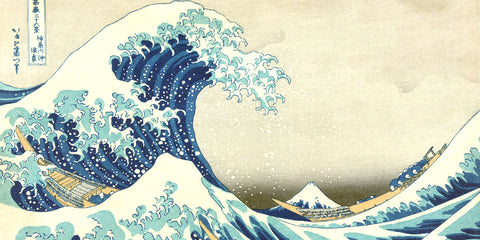Table of Contents:[hide]
Life and Artistic Genesis
Kuniyoshi's artistic journey began at a young age, under the tutelage of Utagawa Toyokuni, a renowned ukiyo-e master. His early exposure to warrior prints and depictions of commoners fueled his artistic passion. Despite facing challenges and economic hardships, Kuniyoshi's encounter with fellow pupil Kunisada reignited his creative spirit, leading to a prolific period of artistic production.
The Evolution of Style
The 1820s marked a turning point for Kuniyoshi as he developed a distinctive style, evident in his heroic triptychs. His breakthrough came in 1827 with the series "One hundred and eight heroes of the popular Suikoden all told," showcasing individual heroes on single sheets. This series not only gained immense popularity but also influenced Edo fashion with the introduction of tattoos on heroes.
Warriors, Legends, and Beyond
Kuniyoshi's artistic repertoire expanded to encompass themes from war tales, such as the "Tale of the Heike" and "The rise and fall of the Minamoto and the Taira." His warrior prints stood out for their emphasis on dreams, ghostly apparitions, omens, and superhuman feats. The artist skillfully satisfied the public's growing fascination with the ghastly and bizarre during that era.
One hundred and eight heroes of the popular Suikoden all told
This is Kuniyoshi’s “great” Suikoden series—the series that made him famous. These prints are the first single-sheet color prints on the Suikoden theme and the first large series of warrior prints designed by any ukiyo-e artist. It is based on stories from the semi-historical Chinese novel, Suikoden (Shuihu zhuan in Chinese). It tells of the adventures of a band of 108 rebels who sought refuge in the margins of Liangshan Marsh. These rebel warriors sought to protect the poor and downtrodden, very much like Robin Hood’s band.
Creative Response to Constraints
The Tenpō Reforms of 1841–1843 imposed restrictions on luxury and banned the illustration of courtesans and actors in ukiyo-e. In response, Kuniyoshi turned to caricature prints, humorously criticizing the shogunate while veiling his commentary allegorically. These prints became popular among the politically dissatisfied public, showcasing Kuniyoshi's creative resourcefulness.
Beyond Boundaries: Landscape and Natural Subjects
Amidst societal constraints, Kuniyoshi explored landscape prints, incorporating Western shading and perspective. Works like "Famous products of the provinces" and "Famous views of the Eastern capital" showcased his adaptability and innovation. Additionally, he delved into works featuring animals, birds, and fish, blending traditional Japanese and Chinese painting styles.
Legacy and Influence
Kuniyoshi's impact extended beyond his lifetime, with numerous pupils continuing his legacy within the Utagawa school. Notable successors like Yoshitoshi and Toyohara Chikanobu developed highly innovative styles, reflecting their master's influence. Kuniyoshi's prints found a place in the permanent collections of prestigious museums worldwide, attesting to his enduring legacy.
Utagawa Kuniyoshi FAQ's
-
Who was Utagawa Kuniyoshi?
- Utagawa Kuniyoshi (1798–1861) was a prominent Japanese artist, known for his mastery of the ukiyo-e style of woodblock prints and paintings during the Edo period.
-
What subjects did Kuniyoshi depict in his artwork?
- Kuniyoshi's subjects ranged widely, including landscapes, beautiful women, Kabuki actors, cats, and mythical animals. He was particularly renowned for his depictions of battles involving legendary samurai heroes.
-
Which school did Kuniyoshi belong to?
- Kuniyoshi was a member of the Utagawa school, and his artistic journey began under the guidance of Utagawa Toyokuni.
-
How did Kuniyoshi's artistic style evolve over time?
- In the 1820s, Kuniyoshi developed a distinctive style, marked by heroic triptychs and individual depictions of heroes. His work incorporated elements of Western representation, and he experimented with large textile patterns and light-and-shadow effects.
-
What challenges did Kuniyoshi face in his career?
- Kuniyoshi faced economic difficulties, resulting in a period of limited artistic output between 1818 and 1827. However, a chance encounter with fellow pupil Kunisada reignited his creative spirit.
-
What major series contributed to Kuniyoshi's popularity?
- Kuniyoshi gained immense popularity with the series "One hundred and eight heroes of the popular Suikoden all told" in 1827. This series featured individual heroes on single sheets and introduced tattoos on heroes, influencing Edo fashion.
-
How did Kuniyoshi respond to the Tenpō Reforms of 1841–1843?
- Faced with restrictions on luxury displays, Kuniyoshi turned to caricature prints that humorously criticized the shogunate. These prints, banned from depicting courtesans and actors, became a form of allegorical commentary and gained popularity.
-
Did Kuniyoshi only focus on warrior prints?
- While Kuniyoshi was renowned for his warrior prints, he also delved into landscape prints, featuring Western shading and perspective. He explored themes outside censorship boundaries, including works on personal travel and natural subjects like animals, birds, and fish.
-
What was Kuniyoshi's influence on his pupils?
- Kuniyoshi had numerous pupils, including Yoshitoshi and Toyohara Chikanobu, who continued his legacy within the Utagawa school. These successors developed highly innovative styles of their own.
-
Where can I view Kuniyoshi's works today?
- Kuniyoshi's prints are held in the permanent collections of many prestigious museums worldwide, including the Metropolitan Museum of Art, the British Museum, and the Van Gogh Museum. His legacy lives on, and his works are often featured in exhibitions celebrating the rich heritage of Japanese ukiyo-e.
Prints and Canvas Panels
Choose from a range of sizes with each listing offered as a fine art print or ready to hang canvas panel.





